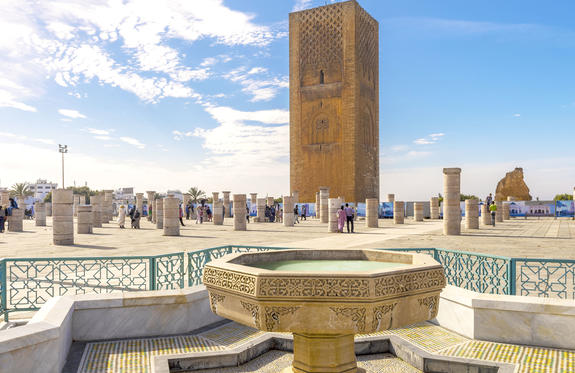
Rabat and its twin city, Sale, overlook the Atlantic Ocean from their location at the mouth of the Bouregreg River. This enchanting city serves as Morocco’s capital and features fascinating Islamic and French-colonial architecture. With a rich historical and cultural heritage, a long coastline with beautiful rocky and sandy beaches, an ecologically diverse countryside, wonderful hiking trails and a vibrant city centre with lush, green parks, the city is a popular destination for travellers. Explore the city on foot, relax on the unspoilt beaches and visit the captivating 12th-century seaside kasbah of Udayas.

Morocco’s second-largest city and the country’s former capital, Fes (Fez) is an exotic mix of Arabic architecture, ancient alleyways calls to prayer and colourful markets; all mixed in with a good dose of modern culture. Home to the venerated Karaouine Mosque, which dates back to 859 AD and incorporates an Islamic university, and to the country’s most hallowed shrine, the Zaouia Moulay Idriss II; Fes is regarded as the spiritual seat of Morocco. Music lovers should try to synchronise their trips with the annual Festival of Sacred Music, one of the highlights of the city’s cultural calendar showcasing diverse performances of spiritual and religious music; while those with a penchant for shopping can browse the mesmerizing colourful markets selling an exquisite array of silver, leather and other handicrafts up for grabs.

M’hamid is a small village in the region of Zagora in southeastern Morocco. It is the last stop before the vast undulating dunes of the Sahara and marks the end of the tar road. It serves as a gateway to the desolate beauty of the desert, which you can experience on a quad bike, camel back or buggy. Sandboarding is another popular activity. Roughly 50 kilometres west of M’hamid are the Erg Chigaga dunes - the highest in all of Morocco, rising 300 metres into the air and stretching for 40 kilometres in length..

The town of Skoura is a beautiful palm-grove-lined oasis, resting on the banks of the seasonal Amerhidl River in the Ouarzazate Province of Morocco (within the scenic Dades valley or ‘Valley of a Thousand Kasbahs’). This flourishing location takes in scenes of the enthralling Atlas Mountains and boasts a multitude of Moroccan castles, vibrant souks, and lush groves of palm, olive, fig, and almond trees. Visitors can look forward to a wide array of impressive sites including the Marabout Sidi M’Barek, a magnificent pre-Islamic Muslim shrine; and the 17th-century Amerhidl Kasbah, a high-walled crenellated fortress known to be one of the largest in Morocco. Other popular Kasbahs include the Dar Ait Sidi el-Mati Kasbah, as well as the spectacular Amar and Ait Ben Abou.

Situated to the north of the foothills of the snow-capped Atlas Mountains and fringing the famed Sahara, the bustling UNESCO-listed city of Marrakesh is an enchanting travel destination. Marrakesh is also home to the largest traditional Berber market in Morocco and one of the busiest squares in the world, known as Djemaa el Fna. Don’t miss the opportunity to visit this square in the evening as it transforms into an enormous, open-air restaurant, and browse through exquisite carpets, spices and a myriad of other items. Art, design and architecture enthusiasts flock to the city to see its incredible artisan achievements, so beautifully expressed at the glorious Bahia Palace, Dar Si Said and Saadian Tombs, as well as at several museums. The other-worldly Jardin Majorelle is also unmissable.

In Morocco within the region of Marrakech-Tensift-Al Haouz you will find the small town of Asni, also known as ‘The Land of the Amethyst’, for its rich deposits of this semi-precious stone. Located about three hours south of the country’s capital city, Sabat, in the Imlil valley at the foothills of the High Atlas Mountains the region offers a myriad of cultural, adventure and nature activities. Visitors can enjoy the area’s pristine valleys and ancient villages through day trips, hiking and camping excursions, as well as walking or cultural tours. Roughly an hour’s drive away you can marvel at Mount Toubkal, part of the Atlas Mountains, and the highest mountain of both Morocco and North Africa, standing at an altitude of 4165 metres. If you happen to be around on Tuesdays and Saturdays, don’t miss the lively farmer’s market in the nearby village of Tahanaout for a true glimpse into local life.




